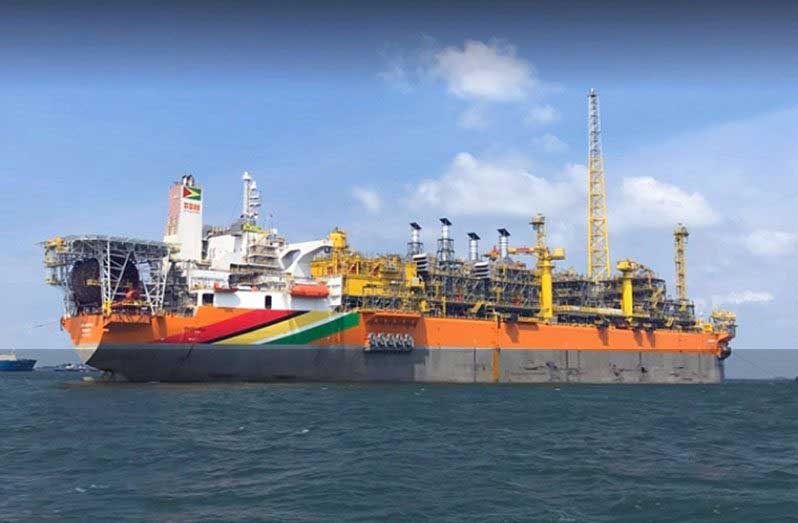–fee increased from US$30 to US$45 per tonne of carbon emitted
EXECUTIVE Director of the Environmental Protection Agency (EPA), Kemraj Parsram, has said that the agency has received approximately $400 million in “flaring fees” from US oil giant, ExxonMobil.
Those fees were paid as a result of an amendment to the Liza Phase One environmental permit, which saw an installed fee for increased flaring activity at the Liza Destiny operations. The amendment was instituted in May and initially stipulated that the operator pay US$30 per tonne of carbon emitted.
During an interview on local radio programme, Guyana’s Oil & You, on Thursday, Parsram said that the policy of EPA and the Government of Guyana has always been zero-routine flaring.
Flaring is the practice of burning the natural gas to ensure safe operations onboard the floating production, storage and offloading (FPSO) vessel. In the case of Guyana, ExxonMobil was forced to flare above the pilot level due to a defective gas compressor.
“The EPA has been engaged with the operator and we have agreed on a way on how we can achieve compliance in this regard.
“It must be noted that the operator has and continues to show effort in addressing the issue and meeting. We have weekly meetings to discuss the status and the progress in meeting this agreed compliance,” the Executive Director related.
Concerns were raised about ExxonMobil and its co-venturers being able to recover the $400 million in fees as per the accounting procedure in the Production Sharing Agreement (PSA).
Vice-President, Bharrat Jagdeo, had, however, affirmed that the government will not be allowing the oil giant to recover those fees.
Due to the damaged compressor, ExxonMobil was compelled to flare natural gas of 15 million standard cubic feet per day (mmscfd) for several months. However, Parsram said that the operator was able to reduce flaring to six mmscfd.
“We are not at pilot flare as yet, but based on the information provided to us and the discussions that we have had, the plan is to fix this issue completely by year end. Based on the efforts and the progress that we have seen so far, we find this reasonable, “he said.
Importantly, the EPA Director said that, subsequent to ExxonMobil reducing its flaring, the agency moved to increase the US$30 fee to US$45 per tonne of carbon emitted.
Notwithstanding this, Parsram said that the EPA is working in partnership with the operator to ensure zero-routine flaring.
On the side of the compromised gas compressor, ExxonMobil has already put in an order for a new compressor from its supplier. That equipment is set to arrive in Guyana by the end of 2021.
It was reported, recently, that considering the challenges created by the defective equipment aboard the Liza Destiny, Minister of Natural Resources, Vickram Bharrat had said that EEPGL will replace the manufacturer of the compressor equipment, to ensure there is no flaring during future projects.
Minister Bharrat said the government took decisive action to effect this change, due to the constant flaring at the Liza Destiny FPSO vessel.
“This now has forced us to enter into engagements with Exxon to ensure that the Unity FPSO that is coming later in this year, and then Prosperity in early 2024, that we don’t have this issue with those FPSOs.
“So, we have gotten that assurance that General Electric will be used as the manufacturer to ensure that the compressor is not a recurring problem on those FPSOs with the gas compressor,” Minister Bharrat related.
According to a report from the Department of Public Information (DPI), General Electric is a US multi-national company.
ExxonMobil had contracted German company, MAN Energy Solutions, to supply the compressor equipment for the Liza Destiny. That company, however, failed to correct the challenges encountered on the equipment used on the Liza Destiny, which have plagued the company’s operations since the beginning of oil production here.
Minister Bharrat said the adjustment was needed since both the Liza Unity and Prosperity are each designed to produce 220,000 barrels of oil per day; almost twice the amount of the Liza Destiny.
Adequate systems for environmental protection are needed especially ahead of increased production offshore Guyana. ExxonMobil has updated its development plans of having five oil production projects by 2026 to six projects by 2027, which they see could potentially grow to ten production projects in the future.
It was reported that Guyana’s role in the global petroleum industry could be bigger than it appears on the surface, as an analysis done by global energy research and consultancy group, Wood Mackenzie, shows that the country is among five nations which will produce most of the remaining deep-water oil resources.
According to the group’s analysis, oil and gas will play a significant role in meeting energy demands for decades to come, especially with the upstream industry expecting to fill the 450 billion barrels of oil equivalent (BoE) of undeveloped supply needed by 2040.
According to the second largest stock exchange in the world by market capitalisation, NASDAQ, Guyana, with its estimated recoverable resources of about nine billion barrels of oil equivalent, is projected to be among the world’s largest per capita oil producers by 2025.




.png)









